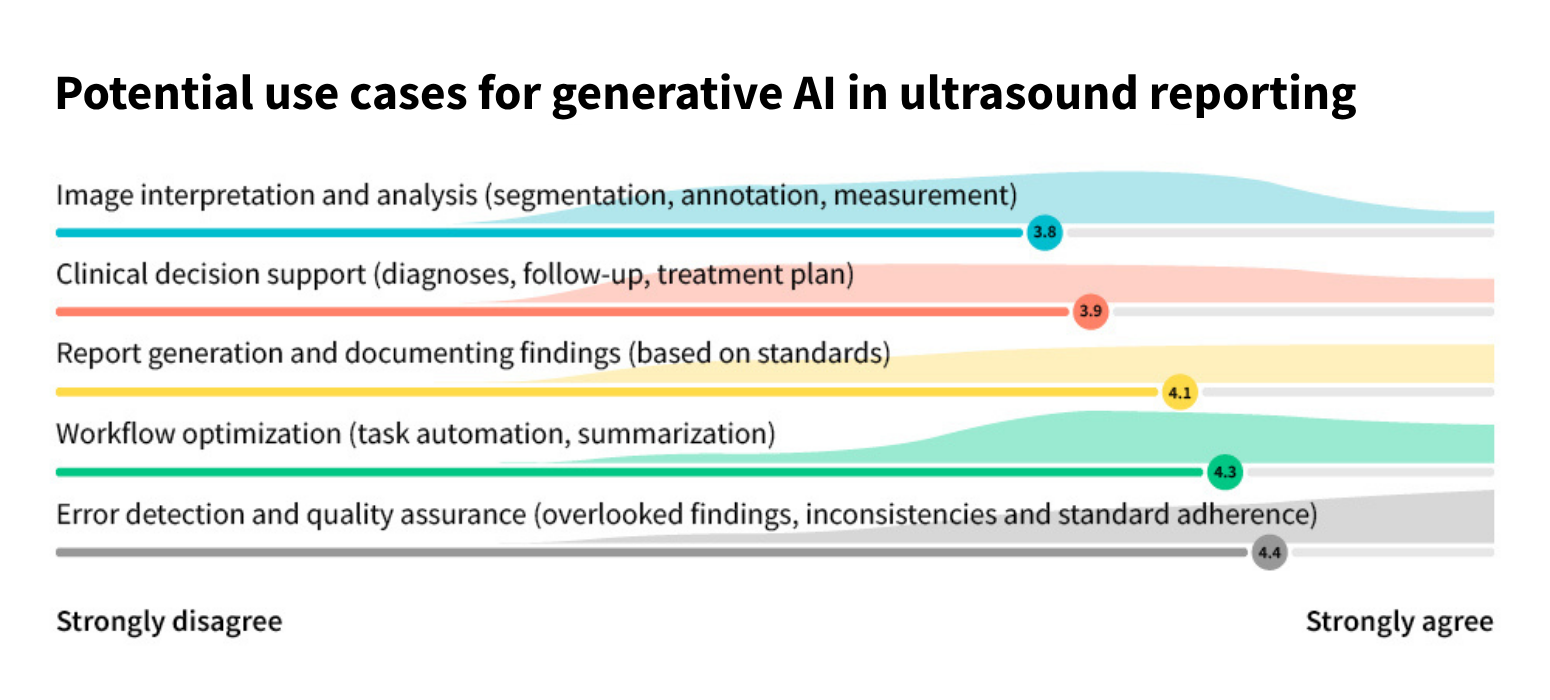Generative AI is reshaping healthcare, and its emerging role in ultrasound reporting is gaining attention. To ensure we are aligning innovation with clinical realities, GE HealthCare surveyed a group of North American radiologists who specialize in ultrasound. We asked where they see promise, what benefits they prioritize, and where they still have concerns when it comes to integrating generative AI into ultrasound reporting. Their responses offer a compelling snapshot of how this technology is being viewed today.
This three-part series explores key findings from this survey. In Part 1, we focus on the highest-rated use cases and what they reveal about the early role of generative AI in ultrasound reporting.
Top-ranked use cases for generative AI in ultrasound reporting
To understand how radiologists specializing in ultrasound view the role of generative AI in reporting, we began with a simple question: where do they see the greatest potential? When asked to rate various applications on a scale from 1 (strongly disagree) to 5 (strongly agree), three priorities stood out:
- Quality assurance and error detection
- Workflow optimization
- Report generation and documenting findings
Consensus on error detection via generative AI
The highest-rated use case was generative AI’s ability to support quality assurance and error detection. In the survey, this was described as flagging overlooked findings, inconsistencies, or deviations from reporting standards.
“The high score for quality assurance and error detection isn’t surprising,” says Ravi Nagavarapu, Senior Global Product Manager, Digital Ecosystems for Medical Device Customers at GE HealthCare. “Radiologists are under constant pressure to maintain consistency across high volumes of exams. Generative AI can act like a second reader, scanning for patterns and catching the kinds of things humans can easily miss in repetitive work.”
This group’s enthusiasm for using generative AI to catch errors suggests a preference for tools that enhance, rather than replace, their expertise. The high ratings point to a practical, collaborative vision for AI where it serves as a second set of eyes, helping uphold accuracy, consistency, and confidence in reporting.
Reporting workflow optimization is welcome
Ultrasound reporting workflow optimization, described in our survey as task automation and summarization, was a close second in the rankings for potential uses of generative AI. This signals recognition of generative AI’s ability to enhance efficiency in ultrasound reporting processes.
Examples could include automatically creating report templates, summarizing clinical context from prior exams, or organizing findings for review. “Radiologists don’t need AI to do the job, they need it to take care of the overhead,” says Nagavarapu. “It’s about reducing the clicks, toggles, and typing. Every minute saved adds up.”
By taking on these routine tasks, generative AI allows radiologists to focus on the parts of their job that require clinical expertise such as interpretation, collaboration, and education. This reallocation of effort will be key to curbing burnout and boreout rates among radiologists.
A spotlight on ultrasound documentation
Rounding out the top three use cases for generative AI in ultrasound reporting was report generation and documenting findings. While documentation is certainly part of the overall workflow, we called it out in the survey because it can be a major source of stress and inefficiency, particularly under time constraints or heavy caseloads. Workflow optimization is about improving how tasks are managed. Documentation focuses on what gets captured in the record and how accurately.
“Documentation isn’t just admin work, it’s the clinical record,” Nagavarapu adds. “Radiologists want tools that help them get it right, get it done quickly, and avoid having to go back and fix errors later.”
When generative AI supports fast, accurate, and standardized reporting, the benefits ripple outward: enhancing billing, compliance, and communication with care teams.
Emerging trust in generative AI for ultrasound decision support
Support was more moderate when it came to generative AI’s potential role in image interpretation or clinical decision support. While respondents did not express disagreement, a notable portion selected neutral responses, suggesting cautious interest or a desire for more evidence before fully embracing generative AI in these areas.
A takeaway here may be that radiologists are open to generative AI support but are still calibrating their comfort level when it comes to higher-stakes tasks like interpretation and diagnostic recommendations.
Additional insight: Ensuring ultrasound exam completeness
In the group discussion following this survey question, participants suggested AI could also help ensure technical completeness during ultrasound exams. One cited the challenge of capturing all required views or measurements.
For instance, in the ICU, an AI-powered assistant could prompt the clinician to check for a Murphy sign when performing an abdominal scan for suspected cholecystitis. In fetal imaging, generative AI could flag if a critical measurement inadvertently missed. One participant said, “If you walk out of the fetal ultrasound and you forgot to measure the femur—it happens, even with the best sonographers—if it [the AI] would just say ‘Stop, go back, you’re missing one.’”
Generative AI’s early sweet spot in ultrasound reporting
The current sentiment among this group of radiologists is clear: Generative AI is best positioned to support routine tasks like documentation, reporting, and quality checks. These applications offer meaningful relief from time-consuming work without interfering with clinical judgment. For now, radiologists see GenAI not as a diagnostic tool, but as an assistant that helps maintain quality and frees up time for deeper interpretation and patient care.
Read the complete series on perceptions of generative AI in ultrasound reporting:
Part 1: Radiologists rank potential use cases
Part 2: Standardization and efficiency take center stage
Part 3: Understanding barriers to adoption
REFERENCES:
Internal data from a GE HealthCare focus group, October 2024
©2025 GE HealthCare. GE is a trademark of General Electric Company used under trademark license.
JB35591XX


